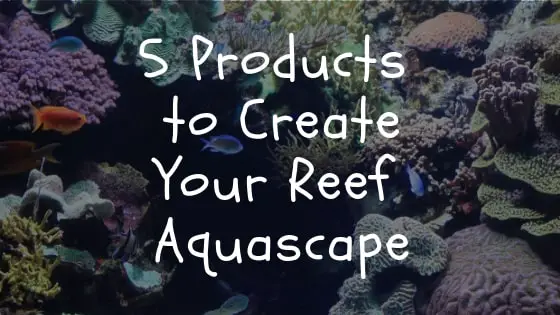Here are 5 products to help you aquascape your saltwater aquarium:
Base Rock
Live rock plays a lot of important roles in a saltwater aquarium. It is the physical and biological backbone of the reef in your home. It’s a place for your fish to hide. It’s a decoration that creates depth and focal points in your aquarium. Live rock is a place to attach your corals.
It is also a place where bacteria and invertebrates live and grow, including those bacteria that serve as the biological filter for your tank.
But harvesting true live rock from the reefs is destructive and can be a vector for transporting pests into your tank. It is also expensive.
A great alternative to ‘real’ live rock is dry base rock.
It starts off colorless and pale, but will quickly become colonized with beneficial bacteria and colorful algae called coralline.
Aquarium Sand
You don’t need sand in an aquarium to have a successful reef tank, but a lot of people, myself included, prefer the way a tank with sand looks. Aquarium sand can also provide a few benefits in a reef tank.
Like live rock, live sand acts as a substrate where beneficial bacteria grow. Those bacteria serve as your biological filter and convert toxic ammonia (in a multi-step process) into nitrate.
Pink live sand
Black live sand
A deep sand bed (which is an aquarium term used to describe a sand bed that is at least 6-inches deep) not only “has the power” to convert ammonia into nitrate, but it also has bacteria that can remove nitrates from the water.
Hacksaw
One of the aspects about live rock that gives it character and makes it look natural and like a living reef is when the shapes are irregular. But a challenge with irregular shapes is that…well…they may fit together irregularly.
The great equalizer with irregularly shaped rocks is my friend shown above, the hacksaw. You see, with a hacksaw, you can keep the visible irregularities that give the rock character on the exposed sides–and then use the saw to make cuts that will allow the rocks to sit and stack and look exactly how you want them to look.
Epoxy and Glue
If you stack your rocks on top of the sand and don’t secure them to each other, you could be in for some problems. Rock piles can tip over and break coral frags, kill corals altogether, or even crack your aquarium glass.
Two products that can help you avoid this mishap are cyanoacrylate (Super Glue) gel and Two-part epoxy.
Super glue gel is better than regular cyanoacrylate because it is thicker–which means it won’t be as runny and will be easier for you, therefore, to attach the rocks.
Superglue may be able to hold a construction worker, by his helmet, to a steel construction beam, but in my experience, it isn’t great for ‘big’ aquascape jobs, it’s best used for those smaller jobs.
I suspect the difference between the commercial and reef applications (besides the obvious that it was just a commercial) is that the irregular shape of live rock makes it difficult to get enough surface area to form a tight bond.
For those larger jobs, I turn to a two-part epoxy, like the one below.
Coralline Algae and Boosters
Ever wonder what that purple and pink stuff on live rock is? That’s coralline algae. You can give your own aquascape a boost of coral by seeding it with coralline algae, like the product shown below:
Or products, like the one below which boost the growth of coralline algae already in your tank.
More information about aquascape
For more information about aquascape, check out these resources:
- The definitive guide to live rock
- How much live rock do I need?
- The truth about aquarium sand
- Picking the right aquarium sand












Leave a Reply